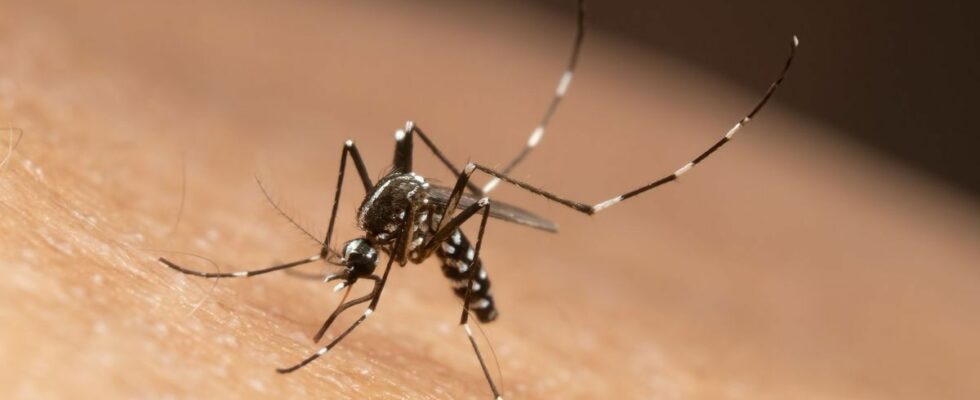Published on
updated on
Reading 3 min.
Now present in 78 departments in metropolitan France, the tiger mosquito exposes us to new diseases. According to health authorities, the occurrence of epidemics linked to the insect is even likely in the next 5 years.
Will we soon have to live with the threat of contracting dengue, chikungunya and Zika? It’s likely. While the tiger mosquito is now present in 78 departments of mainland France, and a few dozen cases of indigenous dengue have emerged, the Directorate General of Health has asked Anses (National Agency for Food, Environmental and Occupational Health Safety) to estimate the probability of outbreaks of arbovirosis. The latter published its conclusions on September 13.
A “fairly high” risk of epidemic within 5 years
If until now, the indigenous cases of viruses transmitted by the tiger mosquito in France have been localized outbreaks, this could change in the coming years. According to ANSES, an epidemic of arbovirosis, all viruses combined, would have a probability of between 6 and 7 on a scale of 0 to 9 of occurring in the next 5 years.
“We speak of an epidemic from the moment when it is not possible to link all infected people to a focus. This means that transmissions escape the control system”explains Émeline Barrès, from the Risk Assessment Department at ANSES, one of the two coordinators of the expertise.
The appearance of an epidemic would then depend on many factors:
- The presence of the tiger mosquito on the territory;
- Climatic conditions favorable to their reproduction (in particular the accumulation of hot days over a given period and precipitation);
- The arrival of infected people from areas where the viruses are circulating;
- The effectiveness of measures to combat tiger mosquitoes and virus transmission.
A lack of means announced
The other regrettable information in this report is the lack of means we currently have to fight mosquitoes. According to ANSES, in the event of an epidemic, the means of prevention and control of arboviruses as we know them could quickly become saturated: “Some of the stakeholders involved in vector monitoring and control that we interviewed during the assessment told us that they would have been overwhelmed if additional cases had occurred in recent years.” says Véronique Raimond, health economist in the Social Sciences, Economy and Society Department of ANSES, the other coordinator of the expertise.
The management of arbovirosis cases requires significant material, financial and human resources to trace all contacts of the infected person over the previous 10 days, monitor the places visited by the patient and eliminate the tiger mosquitoes present. The Agency therefore recommends adapting the resources to the needs of prevention, surveillance and control of arbovirosis.
An epidemic would put the entire health system under strain
Finally, experts believe that the health system would quickly come under strain in the event of a major epidemic. The risk of saturation would be all the greater if this epidemic coincided with another, as was the case in the Antilles in 2020, where a dengue epidemic occurred at the same time as that of Covid-19.
In order to better anticipate the consequences of an arbovirosis epidemic in mainland France, the use of the experiences of overseas departments and regions must be strengthened, announces Anses.
Economic impacts to be expected
While it is unlikely that an arbovirus epidemic in France would have a major impact on the global economy, some sectors could be weakened, such as tourism. A major epidemic could also worsen social inequalities.
In order to encourage everyone to get involved in vector control and disease prevention actions, the Agency finally recommends that citizens and all stakeholders be involved in building strategies to combat arboviruses at the territorial level.
In addition to collective actions to combat the tiger mosquito, the Agency points out that individual actions are also necessary to reduce the risk of an epidemic.
- Regularly empty bowls and other containers filled with water to prevent them from becoming breeding grounds for larvae;
- Cover rainwater collectors with mosquito netting;
- Protect yourself from mosquito bites by wearing long, loose, light-colored clothing and using repellents.
People arriving from an area where arbovirus is circulating must also take precautions to avoid transmitting the viruses:
- protect yourself from mosquito bites;
- report to a healthcare professional at the first symptoms suggestive of arbovirosis (fever, flu-like symptoms, etc.).

